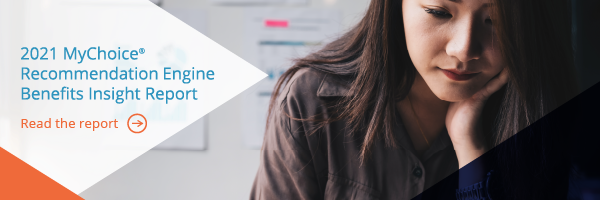Every year, typically in the fall, American workers make their benefits decisions for the coming year.

HR and benefits teams work for months to prepare for annual enrollment, yet for employees it’s generally over in just a few minutes. Most spend less time picking benefits than they do choosing a movie on Netflix. Some don’t even bother to consider their options. They may simply recheck the same proverbial boxes or not even take any action at all if the enrollment is passive.
It’s not because they don’t care. Studies have shown that employees value their benefits highly. In fact, employees not only want more options, they want to be able to personalize their choices.
And therein lies the paradox.
Employees want more benefits choices, but only if those choices are easily comparable.
Employees love benefits, and they want more of them. They want to pick and choose among options to meet their needs, but when annual enrollment rolls around, their aspirations and their actions part ways.
That’s because context is king in benefits decision-making. Given the complexity of benefits, a highly developed platform with a range of access points for employees to find relevant information and make elections is the first step. In the absence of a modern, consumer-like benefits experience, employees may hit a proverbial brick wall in terms of their ability to do the comparison necessary to personalize their choices.
Employees' benefits decisions are based on their mental state.
But even with the advantages of cutting-edge enrollment platforms, there are other key forces at play. Employees don’t make their benefits decisions in a vacuum—their state of mind significantly informs the choices they make. This includes how well they understand benefits, the state of their own health and the health of their family, and even public health concerns. Employees’ financial situation also heavily factors into the mix, along with their personal feelings and perspectives on loss and risk.
Benefits decision-making happens at the intersection of complex options or choices and personal circumstances.
Data can help reveal how employees feel when they enroll in their benefits.
To help mitigate all that complexity, Businessolver offers the MyChoice® Recommendation Engine, a decision guidance tool that connects employees to better benefits choices by taking into account their holistic state of mind. Users answer a set of specially designed questions that help align a benefits recommendation to their specific circumstances around benefits literacy, emotional state and financial health. In short, users tell the MyChoice Recommendation Engine what they’re thinking and/or feeling and it uses that information to suggest the best benefits choices.
Each year, hundreds of thousands of employees use the MyChoice Recommendation Engine to get personalized benefits suggestions. As a result, we have insights into what a representative sample of the workforce is thinking as they consider their benefits choices. For a third year, we have analyzed all that data to create the 2021 MyChoice Recommendation Engine Benefits Insights Report.
In the fall of 2020, we had been living with COVID-19 and its impact for the better part of a year. From an HR and benefits perspective, many parts of the nation had returned to something at least resembling stable. Fall annual enrollments occurred prior to the nationwide infection surges that resulted from holiday gatherings and before any vaccines were approved or administered. Much of the civil unrest that occurred during the summer had slowed and unemployment had decreased to 6.7% in November from a record 14.8% in April. It was in this context that the American workforce made its benefits decisions for 2021.
Things have certainly changed, but these findings offer employers a unique baseline against which the upcoming annual enrollment can ultimately be measured. In this report, we provide a unique snapshot of what employees were thinking and where they were financially at the end of 2019. This was during a time of economic prosperity and relative certainty compared to today. Going forward, it offers important insights into how that pre-pandemic state of mind and people’s financial position may color their benefit choices for this year’s Annual Enrollment season, and it can help employers better prepare for how to conceptualize and deliver benefits options for 2021.
Uncover these insights in the 2021 MyChoice Recommendation Engine Benefits Insights Report below.



